BM461 Global Business Environment: Unilever SWOT and Impact Analysis
VerifiedAdded on 2022/11/25
|6
|1395
|86
Report
AI Summary
This report provides a comprehensive analysis of Unilever's global business environment. It begins with an introduction to the global business environment and its challenges. The main body of the report focuses on a SWOT analysis of Unilever, identifying its strengths, weaknesses, opportunities, and threats. Key drivers from the external and internal environments are highlighted. Following the SWOT analysis, the report examines the operational impact of these key drivers on two of Unilever's functional areas: the finance department and the human resource management department. The finance department's role in managing funds and adapting to increasing demand for products, especially skin care, is discussed. The human resource department's role in hiring and training employees to meet customer demands and utilize new technologies is also analyzed. The report concludes by summarizing the findings and emphasizing the importance of strategic management in the business environment. The analysis is supported by references to relevant academic literature.
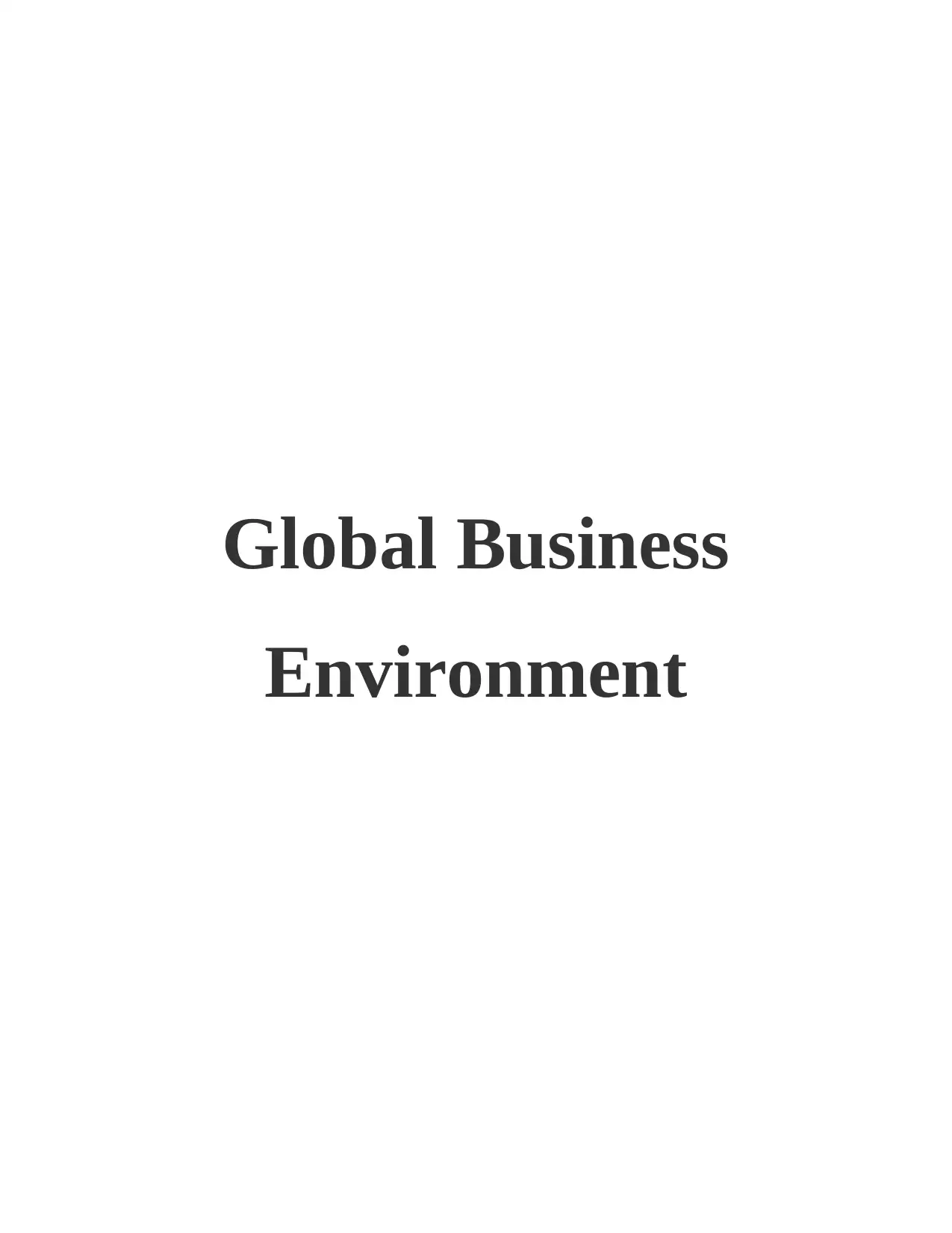
Global Business
Environment
Environment
Paraphrase This Document
Need a fresh take? Get an instant paraphrase of this document with our AI Paraphraser
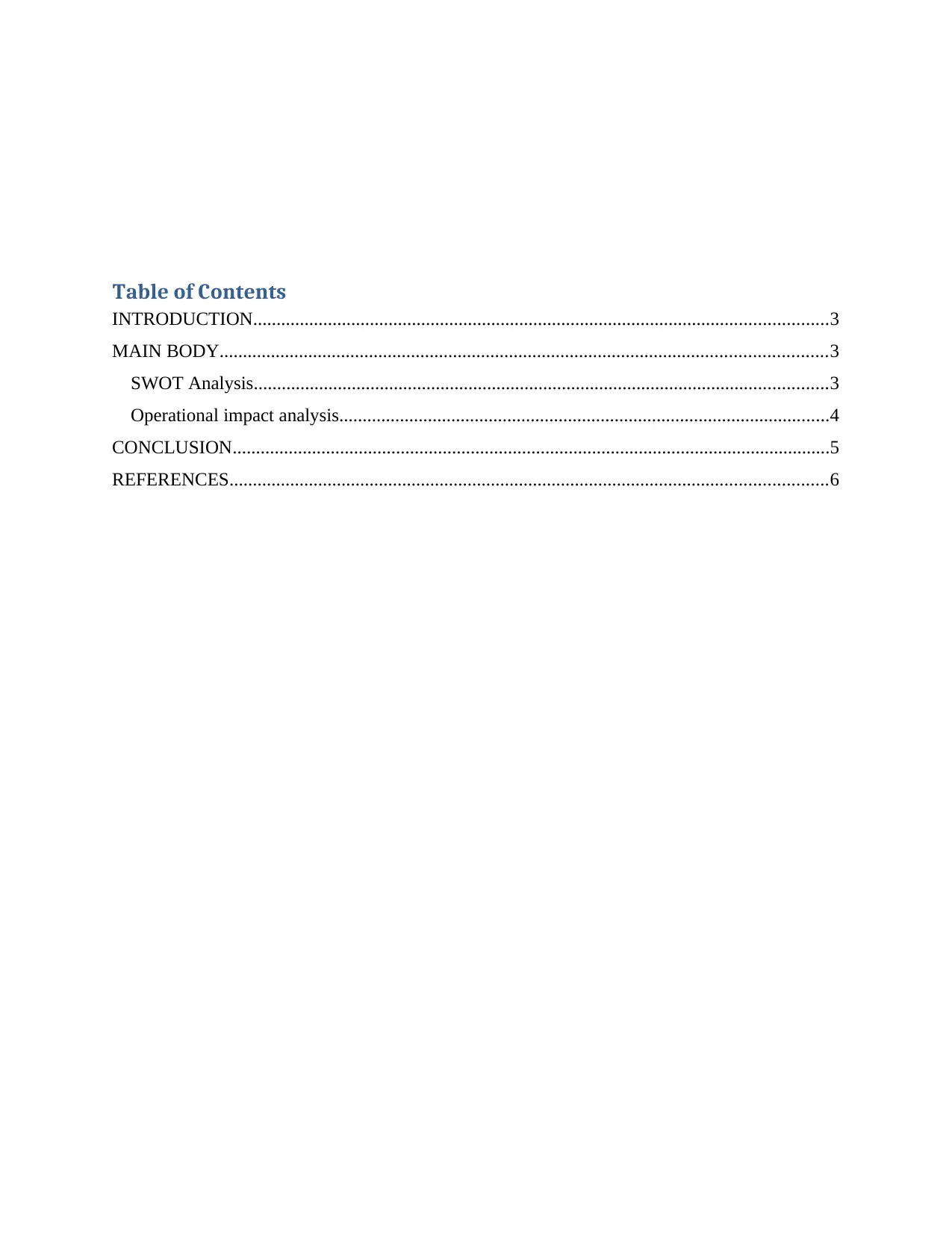
Table of Contents
INTRODUCTION...........................................................................................................................3
MAIN BODY..................................................................................................................................3
SWOT Analysis...........................................................................................................................3
Operational impact analysis.........................................................................................................4
CONCLUSION................................................................................................................................5
REFERENCES................................................................................................................................6
INTRODUCTION...........................................................................................................................3
MAIN BODY..................................................................................................................................3
SWOT Analysis...........................................................................................................................3
Operational impact analysis.........................................................................................................4
CONCLUSION................................................................................................................................5
REFERENCES................................................................................................................................6
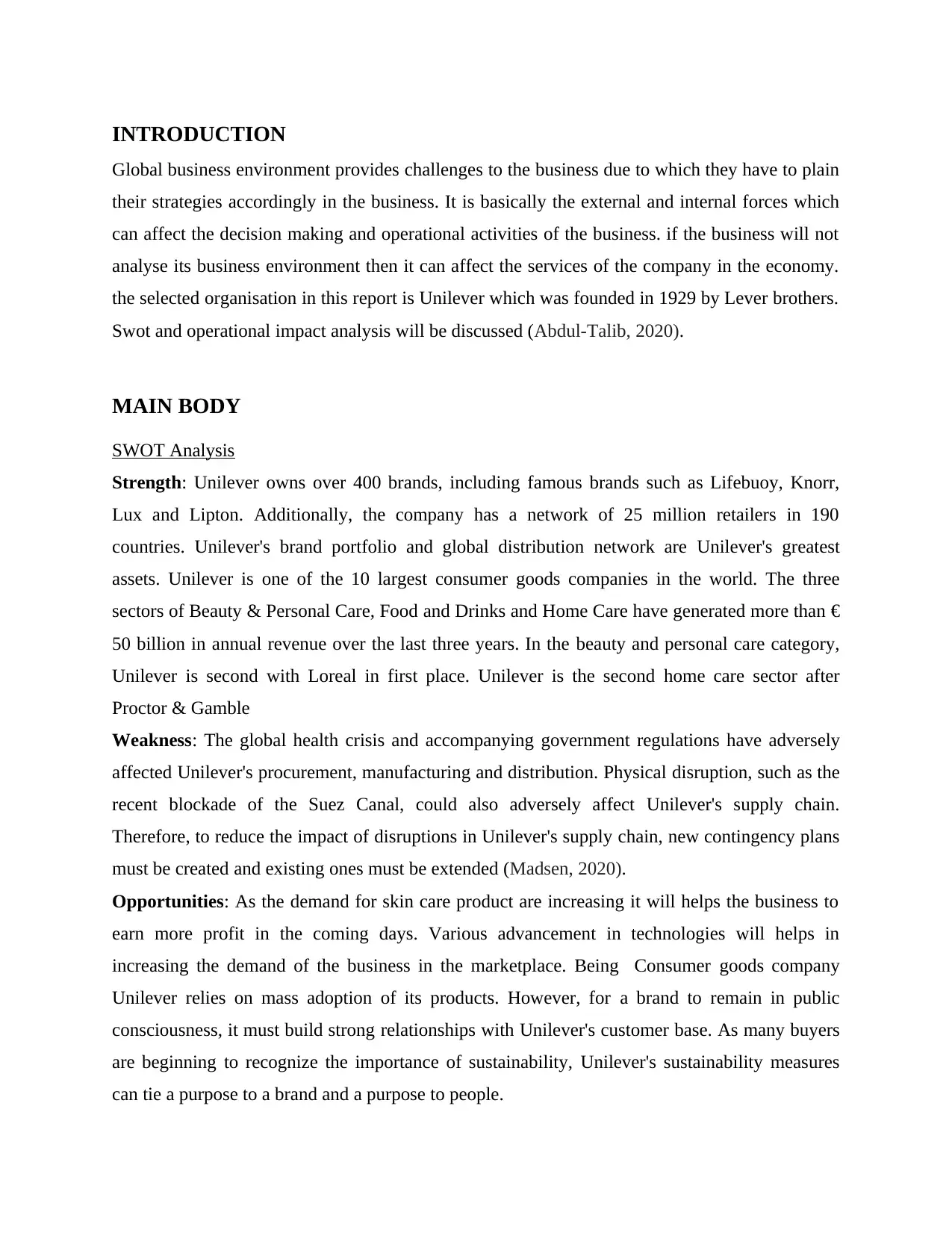
INTRODUCTION
Global business environment provides challenges to the business due to which they have to plain
their strategies accordingly in the business. It is basically the external and internal forces which
can affect the decision making and operational activities of the business. if the business will not
analyse its business environment then it can affect the services of the company in the economy.
the selected organisation in this report is Unilever which was founded in 1929 by Lever brothers.
Swot and operational impact analysis will be discussed (Abdul-Talib, 2020).
MAIN BODY
SWOT Analysis
Strength: Unilever owns over 400 brands, including famous brands such as Lifebuoy, Knorr,
Lux and Lipton. Additionally, the company has a network of 25 million retailers in 190
countries. Unilever's brand portfolio and global distribution network are Unilever's greatest
assets. Unilever is one of the 10 largest consumer goods companies in the world. The three
sectors of Beauty & Personal Care, Food and Drinks and Home Care have generated more than €
50 billion in annual revenue over the last three years. In the beauty and personal care category,
Unilever is second with Loreal in first place. Unilever is the second home care sector after
Proctor & Gamble
Weakness: The global health crisis and accompanying government regulations have adversely
affected Unilever's procurement, manufacturing and distribution. Physical disruption, such as the
recent blockade of the Suez Canal, could also adversely affect Unilever's supply chain.
Therefore, to reduce the impact of disruptions in Unilever's supply chain, new contingency plans
must be created and existing ones must be extended (Madsen, 2020).
Opportunities: As the demand for skin care product are increasing it will helps the business to
earn more profit in the coming days. Various advancement in technologies will helps in
increasing the demand of the business in the marketplace. Being Consumer goods company
Unilever relies on mass adoption of its products. However, for a brand to remain in public
consciousness, it must build strong relationships with Unilever's customer base. As many buyers
are beginning to recognize the importance of sustainability, Unilever's sustainability measures
can tie a purpose to a brand and a purpose to people.
Global business environment provides challenges to the business due to which they have to plain
their strategies accordingly in the business. It is basically the external and internal forces which
can affect the decision making and operational activities of the business. if the business will not
analyse its business environment then it can affect the services of the company in the economy.
the selected organisation in this report is Unilever which was founded in 1929 by Lever brothers.
Swot and operational impact analysis will be discussed (Abdul-Talib, 2020).
MAIN BODY
SWOT Analysis
Strength: Unilever owns over 400 brands, including famous brands such as Lifebuoy, Knorr,
Lux and Lipton. Additionally, the company has a network of 25 million retailers in 190
countries. Unilever's brand portfolio and global distribution network are Unilever's greatest
assets. Unilever is one of the 10 largest consumer goods companies in the world. The three
sectors of Beauty & Personal Care, Food and Drinks and Home Care have generated more than €
50 billion in annual revenue over the last three years. In the beauty and personal care category,
Unilever is second with Loreal in first place. Unilever is the second home care sector after
Proctor & Gamble
Weakness: The global health crisis and accompanying government regulations have adversely
affected Unilever's procurement, manufacturing and distribution. Physical disruption, such as the
recent blockade of the Suez Canal, could also adversely affect Unilever's supply chain.
Therefore, to reduce the impact of disruptions in Unilever's supply chain, new contingency plans
must be created and existing ones must be extended (Madsen, 2020).
Opportunities: As the demand for skin care product are increasing it will helps the business to
earn more profit in the coming days. Various advancement in technologies will helps in
increasing the demand of the business in the marketplace. Being Consumer goods company
Unilever relies on mass adoption of its products. However, for a brand to remain in public
consciousness, it must build strong relationships with Unilever's customer base. As many buyers
are beginning to recognize the importance of sustainability, Unilever's sustainability measures
can tie a purpose to a brand and a purpose to people.
⊘ This is a preview!⊘
Do you want full access?
Subscribe today to unlock all pages.

Trusted by 1+ million students worldwide
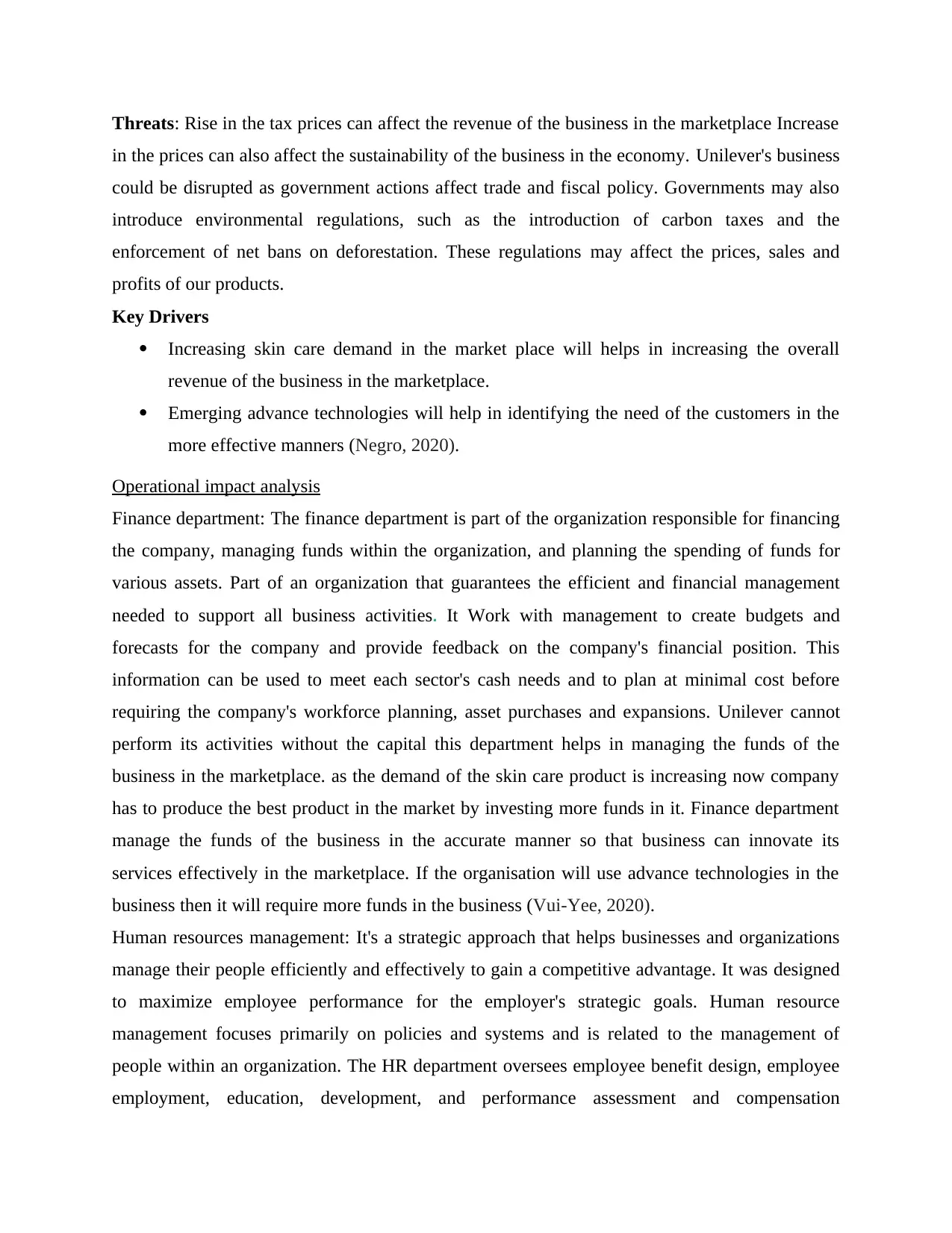
Threats: Rise in the tax prices can affect the revenue of the business in the marketplace Increase
in the prices can also affect the sustainability of the business in the economy. Unilever's business
could be disrupted as government actions affect trade and fiscal policy. Governments may also
introduce environmental regulations, such as the introduction of carbon taxes and the
enforcement of net bans on deforestation. These regulations may affect the prices, sales and
profits of our products.
Key Drivers
Increasing skin care demand in the market place will helps in increasing the overall
revenue of the business in the marketplace.
Emerging advance technologies will help in identifying the need of the customers in the
more effective manners (Negro, 2020).
Operational impact analysis
Finance department: The finance department is part of the organization responsible for financing
the company, managing funds within the organization, and planning the spending of funds for
various assets. Part of an organization that guarantees the efficient and financial management
needed to support all business activities. It Work with management to create budgets and
forecasts for the company and provide feedback on the company's financial position. This
information can be used to meet each sector's cash needs and to plan at minimal cost before
requiring the company's workforce planning, asset purchases and expansions. Unilever cannot
perform its activities without the capital this department helps in managing the funds of the
business in the marketplace. as the demand of the skin care product is increasing now company
has to produce the best product in the market by investing more funds in it. Finance department
manage the funds of the business in the accurate manner so that business can innovate its
services effectively in the marketplace. If the organisation will use advance technologies in the
business then it will require more funds in the business (Vui-Yee, 2020).
Human resources management: It's a strategic approach that helps businesses and organizations
manage their people efficiently and effectively to gain a competitive advantage. It was designed
to maximize employee performance for the employer's strategic goals. Human resource
management focuses primarily on policies and systems and is related to the management of
people within an organization. The HR department oversees employee benefit design, employee
employment, education, development, and performance assessment and compensation
in the prices can also affect the sustainability of the business in the economy. Unilever's business
could be disrupted as government actions affect trade and fiscal policy. Governments may also
introduce environmental regulations, such as the introduction of carbon taxes and the
enforcement of net bans on deforestation. These regulations may affect the prices, sales and
profits of our products.
Key Drivers
Increasing skin care demand in the market place will helps in increasing the overall
revenue of the business in the marketplace.
Emerging advance technologies will help in identifying the need of the customers in the
more effective manners (Negro, 2020).
Operational impact analysis
Finance department: The finance department is part of the organization responsible for financing
the company, managing funds within the organization, and planning the spending of funds for
various assets. Part of an organization that guarantees the efficient and financial management
needed to support all business activities. It Work with management to create budgets and
forecasts for the company and provide feedback on the company's financial position. This
information can be used to meet each sector's cash needs and to plan at minimal cost before
requiring the company's workforce planning, asset purchases and expansions. Unilever cannot
perform its activities without the capital this department helps in managing the funds of the
business in the marketplace. as the demand of the skin care product is increasing now company
has to produce the best product in the market by investing more funds in it. Finance department
manage the funds of the business in the accurate manner so that business can innovate its
services effectively in the marketplace. If the organisation will use advance technologies in the
business then it will require more funds in the business (Vui-Yee, 2020).
Human resources management: It's a strategic approach that helps businesses and organizations
manage their people efficiently and effectively to gain a competitive advantage. It was designed
to maximize employee performance for the employer's strategic goals. Human resource
management focuses primarily on policies and systems and is related to the management of
people within an organization. The HR department oversees employee benefit design, employee
employment, education, development, and performance assessment and compensation
Paraphrase This Document
Need a fresh take? Get an instant paraphrase of this document with our AI Paraphraser
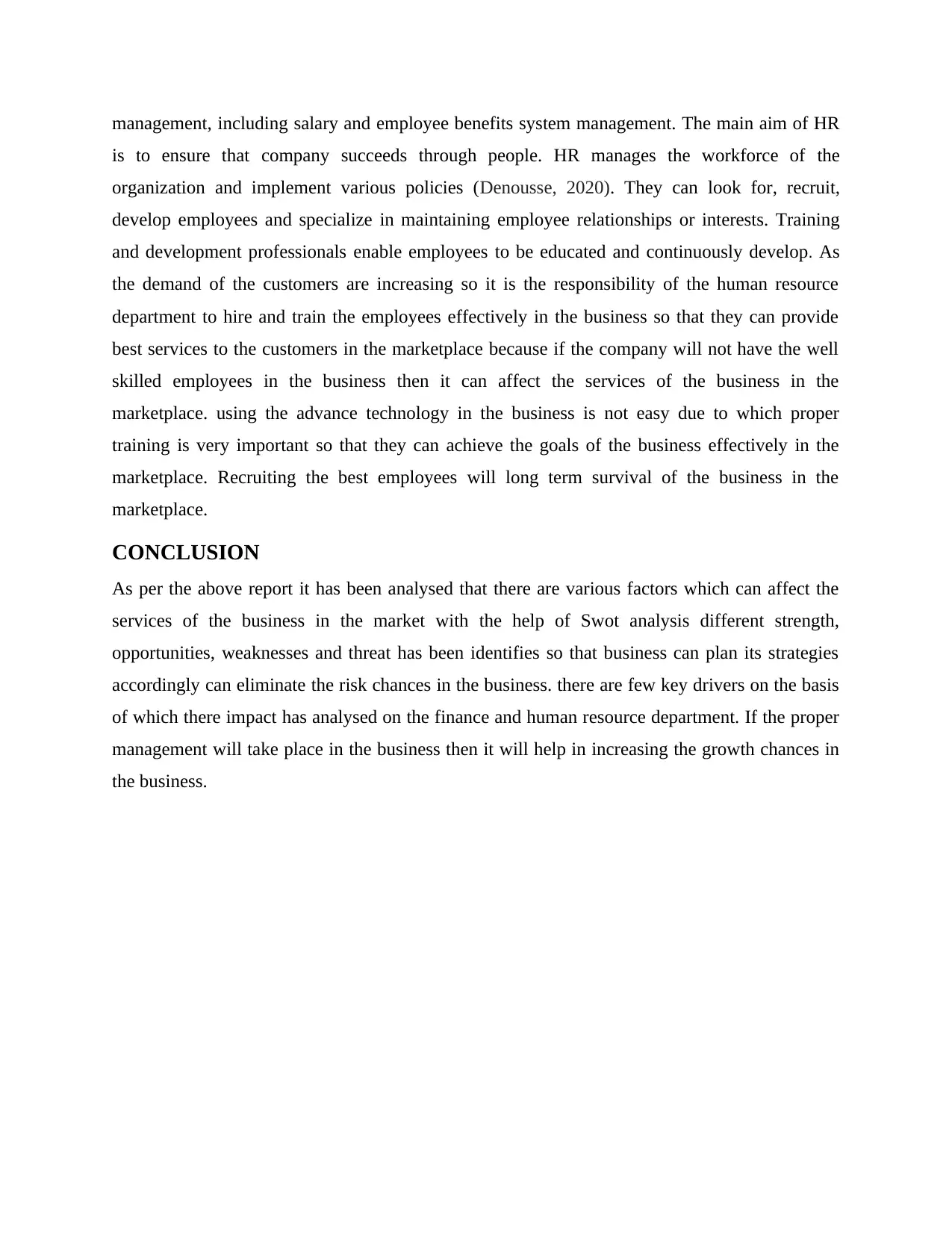
management, including salary and employee benefits system management. The main aim of HR
is to ensure that company succeeds through people. HR manages the workforce of the
organization and implement various policies (Denousse, 2020). They can look for, recruit,
develop employees and specialize in maintaining employee relationships or interests. Training
and development professionals enable employees to be educated and continuously develop. As
the demand of the customers are increasing so it is the responsibility of the human resource
department to hire and train the employees effectively in the business so that they can provide
best services to the customers in the marketplace because if the company will not have the well
skilled employees in the business then it can affect the services of the business in the
marketplace. using the advance technology in the business is not easy due to which proper
training is very important so that they can achieve the goals of the business effectively in the
marketplace. Recruiting the best employees will long term survival of the business in the
marketplace.
CONCLUSION
As per the above report it has been analysed that there are various factors which can affect the
services of the business in the market with the help of Swot analysis different strength,
opportunities, weaknesses and threat has been identifies so that business can plan its strategies
accordingly can eliminate the risk chances in the business. there are few key drivers on the basis
of which there impact has analysed on the finance and human resource department. If the proper
management will take place in the business then it will help in increasing the growth chances in
the business.
is to ensure that company succeeds through people. HR manages the workforce of the
organization and implement various policies (Denousse, 2020). They can look for, recruit,
develop employees and specialize in maintaining employee relationships or interests. Training
and development professionals enable employees to be educated and continuously develop. As
the demand of the customers are increasing so it is the responsibility of the human resource
department to hire and train the employees effectively in the business so that they can provide
best services to the customers in the marketplace because if the company will not have the well
skilled employees in the business then it can affect the services of the business in the
marketplace. using the advance technology in the business is not easy due to which proper
training is very important so that they can achieve the goals of the business effectively in the
marketplace. Recruiting the best employees will long term survival of the business in the
marketplace.
CONCLUSION
As per the above report it has been analysed that there are various factors which can affect the
services of the business in the market with the help of Swot analysis different strength,
opportunities, weaknesses and threat has been identifies so that business can plan its strategies
accordingly can eliminate the risk chances in the business. there are few key drivers on the basis
of which there impact has analysed on the finance and human resource department. If the proper
management will take place in the business then it will help in increasing the growth chances in
the business.
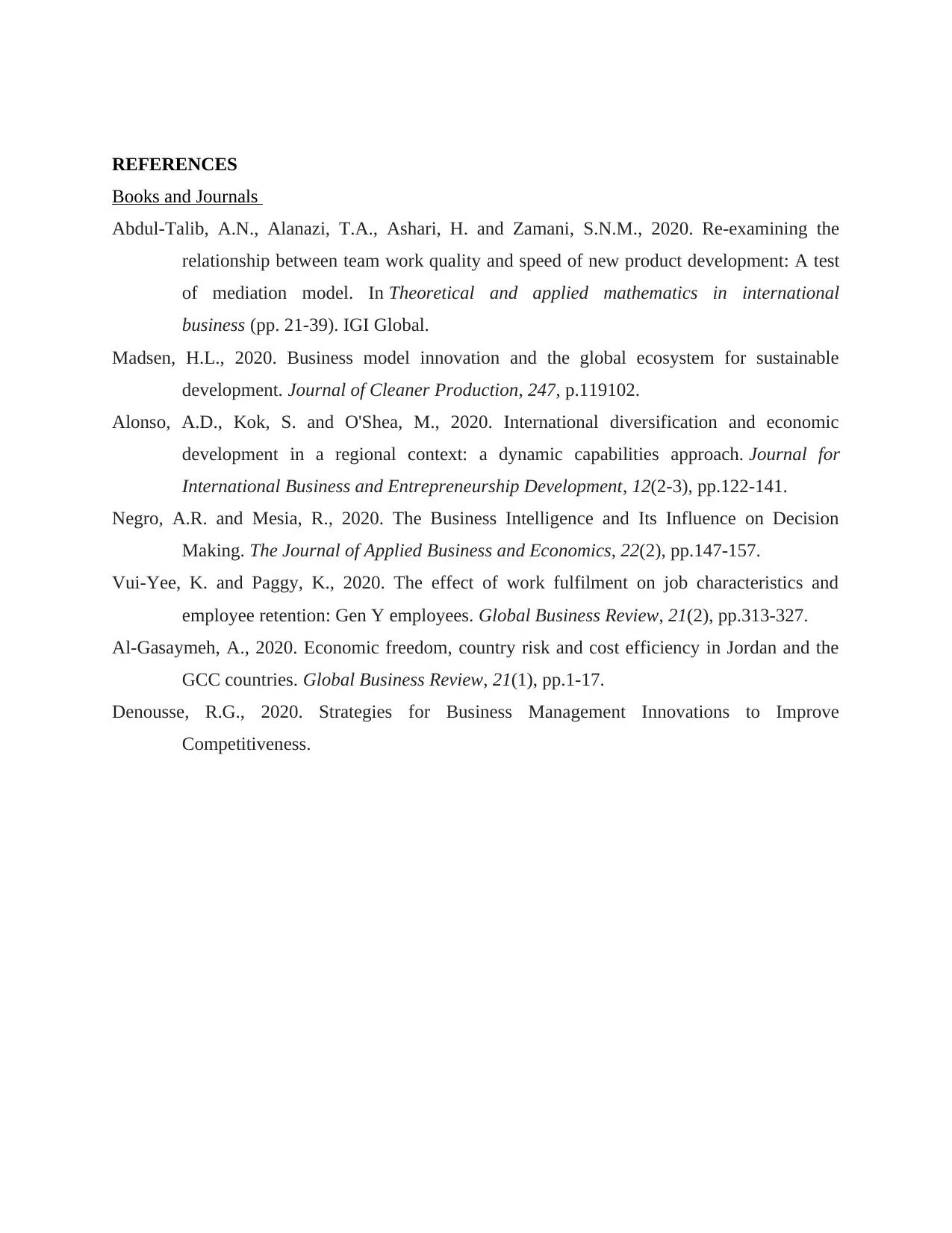
REFERENCES
Books and Journals
Abdul-Talib, A.N., Alanazi, T.A., Ashari, H. and Zamani, S.N.M., 2020. Re-examining the
relationship between team work quality and speed of new product development: A test
of mediation model. In Theoretical and applied mathematics in international
business (pp. 21-39). IGI Global.
Madsen, H.L., 2020. Business model innovation and the global ecosystem for sustainable
development. Journal of Cleaner Production, 247, p.119102.
Alonso, A.D., Kok, S. and O'Shea, M., 2020. International diversification and economic
development in a regional context: a dynamic capabilities approach. Journal for
International Business and Entrepreneurship Development, 12(2-3), pp.122-141.
Negro, A.R. and Mesia, R., 2020. The Business Intelligence and Its Influence on Decision
Making. The Journal of Applied Business and Economics, 22(2), pp.147-157.
Vui-Yee, K. and Paggy, K., 2020. The effect of work fulfilment on job characteristics and
employee retention: Gen Y employees. Global Business Review, 21(2), pp.313-327.
Al-Gasaymeh, A., 2020. Economic freedom, country risk and cost efficiency in Jordan and the
GCC countries. Global Business Review, 21(1), pp.1-17.
Denousse, R.G., 2020. Strategies for Business Management Innovations to Improve
Competitiveness.
Books and Journals
Abdul-Talib, A.N., Alanazi, T.A., Ashari, H. and Zamani, S.N.M., 2020. Re-examining the
relationship between team work quality and speed of new product development: A test
of mediation model. In Theoretical and applied mathematics in international
business (pp. 21-39). IGI Global.
Madsen, H.L., 2020. Business model innovation and the global ecosystem for sustainable
development. Journal of Cleaner Production, 247, p.119102.
Alonso, A.D., Kok, S. and O'Shea, M., 2020. International diversification and economic
development in a regional context: a dynamic capabilities approach. Journal for
International Business and Entrepreneurship Development, 12(2-3), pp.122-141.
Negro, A.R. and Mesia, R., 2020. The Business Intelligence and Its Influence on Decision
Making. The Journal of Applied Business and Economics, 22(2), pp.147-157.
Vui-Yee, K. and Paggy, K., 2020. The effect of work fulfilment on job characteristics and
employee retention: Gen Y employees. Global Business Review, 21(2), pp.313-327.
Al-Gasaymeh, A., 2020. Economic freedom, country risk and cost efficiency in Jordan and the
GCC countries. Global Business Review, 21(1), pp.1-17.
Denousse, R.G., 2020. Strategies for Business Management Innovations to Improve
Competitiveness.
⊘ This is a preview!⊘
Do you want full access?
Subscribe today to unlock all pages.

Trusted by 1+ million students worldwide
1 out of 6
Related Documents
Your All-in-One AI-Powered Toolkit for Academic Success.
+13062052269
info@desklib.com
Available 24*7 on WhatsApp / Email
![[object Object]](/_next/static/media/star-bottom.7253800d.svg)
Unlock your academic potential
Copyright © 2020–2025 A2Z Services. All Rights Reserved. Developed and managed by ZUCOL.





